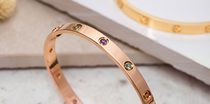Clear all filters
All our Bracelets jewel
Bracelet
20 items
The bracelet, a jewel witnessing its eras
Let's not deny that the existence of the bracelet goes back to prehistoric times, but let's take a leap in time to talk about eras when jewelry was closer to those we know today: antiquity with the appearance of precious metals, the discovery of gold and the first goldsmithing techniques; the Renaissance, where ornaments of all kinds testified to the rank of their owners. At the end of the Middle Ages, the time was for imposing jewelry loaded with stones, and bracelets were no exception to this rule. They take precedence over bracelets as appreciated in particular by the Romans, in the form of a rather simple ring, which is now called the bracelet rush. Another leap in time takes us directly to the 19th century and actually to the industrial revolution. It is indeed at this time that another type of bracelet seduces women, the cuff bracelet. Technical developments helping, the clothing revival also, the jewel becomes wide and perfectly fits the shape of the wrist: the cuff bracelet is often formed of small gold patterns articulated between them. The Second Empire was a fertile period for jewelry in general, with the appearance of themes such as naturalist jewelry and jewelry of feeling. The bracelets in Chaumet's Josephine collection, in particular, are a contemporary reinterpretation of this today. Cuffs would make a strong comeback in the 1930s, but before that, the Art Deco movement would have signed the great return of diamonds and stones as well as the advent of geometric patterns and platinum work. World War II then forced a return to simplicity, but extravagance and color were back in the 1960s. What's more with the fashion for ethnic bracelets, inspired by African, Indian, etc. cultures, pieces like the bangle make their appearance. The exuberance, graphic lines, and pop colors of the eighties still inspire jewelers today - Bulgari's Wild Pop line comes to mind, for example - when the slap bracelets of the following decade are more about costume jewelry. Today, this rich history allows for great freedom in the creation of luxury bracelets. Like Boucheron's Collection Quatre, the same line comes in classic bracelets, chain bracelets or cuffs. As for small bracelets, they lead us to another trend, that of stacking, in other words, accumulation. The 21st century bracelet is no longer worn alone and leaves the door open to creativity.
Cult bracelets, entered the history of jewelry
Many jewelry Houses have created iconic bracelets. Some, by their design, their inspiration or the technique used have become cult. They could, also, be popularized by personalities or stars of the big screen. The best examples in this regard are certainly signed Cartier. The panther became the emblem of the Parisian House from the moment Jeanne Toussaint became its artistic director (1933). The Panther bracelet made its appearance in 1958, a gold band bracelet where two heads have the coat set with diamonds and sapphires when the eyes are emerald. Repeatedly revisited by Cartier, this bracelet remains an indestructible, in the same way as the Love bracelet, in another register. Created in 1969 by Aldo Cipullo, it is characterized by its minimalist style, but above all symbolizes eternal love, since once attached it can only be opened with a dedicated tool. Love has, moreover, been immortalized by mythical couples, Nancy and Frank Sinatra, Elisabeth Taylor and Richard Burton ... This bracelet is still today part of the must-have of jewelry, as another model, Clou de Cartier. Among the other jewelers whose bracelets have gone down in history, it is easy to cite Bulgari and Van Cleef & Arpels, and especially for their creative spirit and expertise. Indeed, it is to the Italian House that we owe the flexible Tubogas rings reproducing the undulations of the snake on the Serpenti bracelet when the Place Vendôme jeweler was inspired by the discovery of Tutankhamen's tomb, in 1922, to create its Egyptian bracelet. A model of craftsmanship, the ribbon bracelet is composed of six plates on which Egyptian motifs in sapphires, rubies, emeralds, onyx and diamonds are depicted. The Van Cleef & Arpels bracelet is now a collector's item, while others continue their life as iconic jewelry. These include the Anchor Chain from Hermès and Force 10, Fred's signature bracelet. In any case, these models testify to the diversity offered by luxury bracelets, capable of adapting to each and every person's style. "








